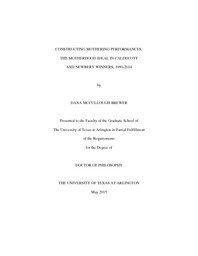
ATTENTION: The works hosted here are being migrated to a new repository that will consolidate resources, improve discoverability, and better show UTA's research impact on the global community. We will update authors as the migration progresses. Please see MavMatrix for more information.
Show simple item record
| dc.contributor.author | McCullough Brewer, Dana | en_US |
| dc.date.accessioned | 2015-07-31T22:10:11Z | |
| dc.date.available | 2015-07-31T22:10:11Z | |
| dc.date.submitted | January 2015 | en_US |
| dc.identifier.other | DISS-13108 | en_US |
| dc.identifier.uri | http://hdl.handle.net/10106/25067 | |
| dc.description.abstract | This project examines representations of motherhood in Caldecott and Newbery winners from 1980-2014 and is informed by feminist literary theory, juvenile literary theory, and motherhood studies. While motherhood studies are evolving to consider egalitarian ideas of motherhood and multiple definitions of motherhood, many Caldecott and Newbery Medal winners present a traditional (and antiquated) motherhood ideal in which maternal figures tend to domestic duties and provide selfless nurturing of children. This objectification depersonalizes, essentializes, and stereotypes motherhood. Diverse mothering characters and practices do materialize in some texts but are often regulated by the motherhood ideal. In Chapter 2, I define the Caldecott motherhood ideal by analyzing a pre-1980 Caldecott text (Sylvester & the Magic Pebble), and then I use award winners from 1980-2014 to demonstrate the continued presence of the motherhood ideal. I contend that the texts in Chapter 2 essentialize motherhood by associating it with femaleness, and they prescribe homogenized mothering experiences. In Chapter 3, I define the motherhood ideal exemplar in Newbery texts (specifically Jacob Have I Loved and Shiloh). In this chapter, I clarify the case for acculturation in juvenile literature. In Chapter 4, I define "diverse" mothering experiences depicted in the Newbery texts from 1980-2014 as found in The Tale of Despereaux; Flora & Ulysses; Kira-Kira; Out of the Dust; Dear Mr. Henshaw; Dead End in Norvelt; and When You Reach Me. The texts in Chapter 4 demonstrate that emphasizing the action of mothering rather than promoting a naturalness allows for progressive and/or non-traditional mothering. Still, the texts in this chapter demonstrate that the motherhood ideal becomes a reactionary force against diverse mothering practices and limits the possibility for fictional explorations of egalitarian parenting. In Chapter 5, I argue that the motherhood ideal prescribes resolutions for mother/daughter conflicts in Jacob Have I Loved, When You Reach Me, Kira-Kira, and Flora & Ulysses. I contend that Walk Two Moons rejects the motherhood ideal myth as it explores maternal anxieties. In Chapter 6, I analyze replacement mothers and temporary mothers in A Gathering of Days; Sarah, Plain and Tall; Bud, Not Buddy; and The Higher Power of Lucky. | en_US |
| dc.description.sponsorship | Morris, Tim | en_US |
| dc.language.iso | en | en_US |
| dc.publisher | English | en_US |
| dc.title | Constructing Mothering Performances: The Motherhood Ideal In Caldecott And Newbery Winners, 1980-2014 | en_US |
| dc.type | Ph.D. | en_US |
| dc.contributor.committeeChair | Morris, Timothy R. | en_US |
| dc.degree.department | English | en_US |
| dc.degree.discipline | English | en_US |
| dc.degree.grantor | University of Texas at Arlington | en_US |
| dc.degree.level | doctoral | en_US |
| dc.degree.name | Ph.D. | en_US |
Files in this item
- Name:
- McCulloughBrewer_uta_2502D_131 ...
- Size:
- 2.463Mb
- Format:
- PDF
This item appears in the following Collection(s)
Show simple item record


